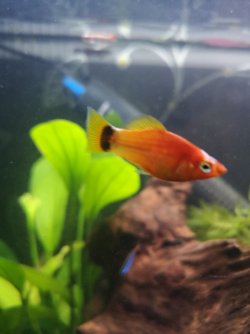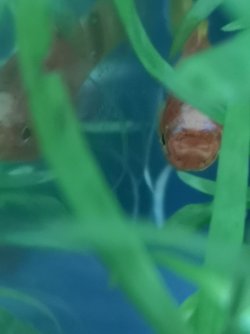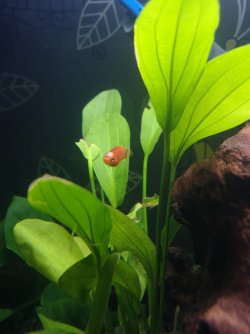Hi, one of my male platies 'went missing' for a few days after I transferred him into the new tank. When he reappeared he has a white patch on his head and one on his tail. They haven't got any bigger and he's swimming around happy enough and eating. Does anyone have any ideas what this is? I wondered if someone had had a go at him and he was hiding or if he'd got himself stuck somewhere and hurt himself getting free.
You are using an out of date browser. It may not display this or other websites correctly.
You should upgrade or use an alternative browser.
You should upgrade or use an alternative browser.
White patch on platy
- Thread starter Kelp23
- Start date
The April FOTM Contest Poll is open!

🏆 Click to vote! 🏆
Hard to see what it is, could be the beginning of fungus, could be wounds where he lost scales. Do you have a quarantine tank? Personally I'd quarantine him and use salt treatment. Salt inhibits bacterial and fungal growth, so it can be a good first line treatment. Treating him in quarantine means the rest of your fish, plants, crayfish etc won't have to be salted. Lots of water changes with fresh clean water essential whether he moves to quarantine or remains in the main tank.
Thanks, I do have a quarantine tank so I'll try and catch him. I do water changes every week. This tank is less than a week old anyway and I only used clean water.Hard to see what it is, could be the beginning of fungus, could be wounds where he lost scales. Do you have a quarantine tank? Personally I'd quarantine him and use salt treatment. Salt inhibits bacterial and fungal growth, so it can be a good first line treatment. Treating him in quarantine means the rest of your fish, plants, crayfish etc won't have to be salted. Lots of water changes with fresh clean water essential whether he moves to quarantine or remains in the main tank.
Oh I'm not saying that you don't water change enough, didn't mean to give that impression. Just while he's in treatment, I'd up them. Every day or every other day. While a fish has an injury to its scales, or has another condition like fungus or a bacterial infection, they're vulnerable. If the scales are damaged, it's an entry point for fungus or bacteria, so secondary infections are common after an injury.Thanks, I do have a quarantine tank so I'll try and catch him. I do water changes every week. This tank is less than a week old anyway and I only used clean water.
Increased water changes not only keeps nitrates close to zero, meaning minimum stress on the fish, but also means you're removing quantities of bacteria and fungal spores that could infect the fish. Bacteria multiply quickly, but if they're being knocked back every day with big water changes, it keeps their numbers in check, while keeping the fish in the cleanest water possible, gives them a better chance of avoiding secondary infections from bacteria and fungus that are always present in fish tanks.
Not at all a criticism of your husbandry! Just standard early treatment when you spot something like this on a fish, to prevent it getting worse. I followed the same plan for a young guppy who had a horrible injury. I lifted the sponge filter out of the tank for cleaning, as normal, and she must have been caught up in it somehow, and went over the side of the tank. It tore most of her tail off
I didn't think you were implying that. Don't worryOh I'm not saying that you don't water change enough, didn't mean to give that impression. Just while he's in treatment, I'd up them. Every day or every other day. While a fish has an injury to its scales, or has another condition like fungus or a bacterial infection, they're vulnerable. If the scales are damaged, it's an entry point for fungus or bacteria, so secondary infections are common after an injury.
Increased water changes not only keeps nitrates close to zero, meaning minimum stress on the fish, but also means you're removing quantities of bacteria and fungal spores that could infect the fish. Bacteria multiply quickly, but if they're being knocked back every day with big water changes, it keeps their numbers in check, while keeping the fish in the cleanest water possible, gives them a better chance of avoiding secondary infections from bacteria and fungus that are always present in fish tanks.
Not at all a criticism of your husbandry! Just standard early treatment when you spot something like this on a fish, to prevent it getting worse. I followed the same plan for a young guppy who had a horrible injury. I lifted the sponge filter out of the tank for cleaning, as normal, and she must have been caught up in it somehow, and went over the side of the tank. It tore most of her tail off View attachment 112746My quarantine tank was already occupied, so I had to treat the whole tank, but it worked well. She could swim, but not as well as usual, so target fed her. By the next morning, she had fungus on her tail stump and on her body where she hit the stand, and she looked in a bad way. But within a few days of salt treatment and daily water changes, she'd fought off the fungus and within a week or so, I could see regrowth on her tail. She was a half grown sub adult when this happened, and now she's my largest, healthiest female, only a scar on her tail to show for this.View attachment 112747Without the salt and daily changes, I'm sure she would have died. She just needed that little bit of help to fight off the fungus while her body repaired the damage.
Ok, so my quarantine tank is small, filtered and treated with tapsafe. Assuming I catch him how much salt do I add and does it need to be a specific type of salt? Do I need to do anything else to my main tank as a precaution ( other than my water change)?
Use either rock salt or aquarium salt (from any fish store, or online). Day one, 1 teaspoon of salt per 5 litres of water. Day two, increase to two teaspoons per 5 litres.I didn't think you were implying that. Don't worry
Ok, so my quarantine tank is small, filtered and treated with tapsafe. Assuming I catch him how much salt do I add and does it need to be a specific type of salt? Do I need to do anything else to my main tank as a precaution ( other than my water change)?
ETA: You can use salt treatment for up to two weeks. Hopefully you'll start to see an improvement before then, and can start lowering the amount of salt through smaller water changes without re-dosing the salt. If you can manage to get any clearer photos of the patches on him in the meantime, someone more experienced may be able to diagnose exactly what's going on with him. Do the patches look at all fuzzy or fluffy? Or more flat?
It looks flat to me. The other male platy keeps chasing him but I'm struggling to catch him. I'm going to get up early tomorrow and do a big water change. I saw another platy flashing earlier so should I just salt treat the entire tank?Use either rock salt or aquarium salt (from any fish store, or online). Day one, 1 teaspoon of salt per 5 litres of water. Day two, increase to two teaspoons per 5 litres.
ETA: You can use salt treatment for up to two weeks. Hopefully you'll start to see an improvement before then, and can start lowering the amount of salt through smaller water changes without re-dosing the salt. If you can manage to get any clearer photos of the patches on him in the meantime, someone more experienced may be able to diagnose exactly what's going on with him. Do the patches look at all fuzzy or fluffy? Or more flat?
If everything in the tank is salt tolerant, then it might be best to treat the whole tank, but you have crayfish don't you? I don't know how they do in salt, I have no knowledge base for them.
I'm not anywhere near to an expert on fish disease. With the one platy with physical signs of either injury or fungus, isolating and salt treatment makes sense. If you're seeing signs of other things wrong with the tank like flashing, you'd do best to get some advice and more definitive diagnosis from someone else who has a lot more experience and knowledge.
Yikes, have just seen how big the patch is on his head, this is more worrying than I'd imagined, especially with other fish flashing. All I know about flashing is it means something is irritating them, and could be internal or external. Wish @Colin_T was around! @Byron, @Fishmanic, any thoughts?
@Kelp23, do a search on wetwebmedia for the white patches, and flashing, see what comes up. There are experts on disease writing for that site, and it's a font of well researched information and treatments.
I'm not anywhere near to an expert on fish disease. With the one platy with physical signs of either injury or fungus, isolating and salt treatment makes sense. If you're seeing signs of other things wrong with the tank like flashing, you'd do best to get some advice and more definitive diagnosis from someone else who has a lot more experience and knowledge.
Yikes, have just seen how big the patch is on his head, this is more worrying than I'd imagined, especially with other fish flashing. All I know about flashing is it means something is irritating them, and could be internal or external. Wish @Colin_T was around! @Byron, @Fishmanic, any thoughts?
@Kelp23, do a search on wetwebmedia for the white patches, and flashing, see what comes up. There are experts on disease writing for that site, and it's a font of well researched information and treatments.
In 95% of the time, flashing is ich. Raising the tank water temperature to 86F/30C for two weeks is a good start. Don't know what other fish are here, but if only livebearers they will be fine. Do a major water change to start, and increase the temp several degrees with that, and adjust the heater. Of course, if you are living in a heat wave, the water may already be this warm, but you have to keep it at or above 86F/30C for two weeks. I would not use salt yet. No idea what the white on the platy is.
Latest Discussions
- Replies
- 1
- Views
- 37
- Replies
- 5
- Views
- 52
- Replies
- 5
- Views
- 63
- Replies
- 1
- Views
- 45
- Replies
- 1
- Views
- 66
trending
-
-
-
-
-
F-1 Angel... a bit nervous... it'll be my 1st F-1 fish...
- Started by Magnum Man
- Replies: 17
Staff online
-
GaryEModerator
Members online
Total: 448 (members: 9, guests: 439)




